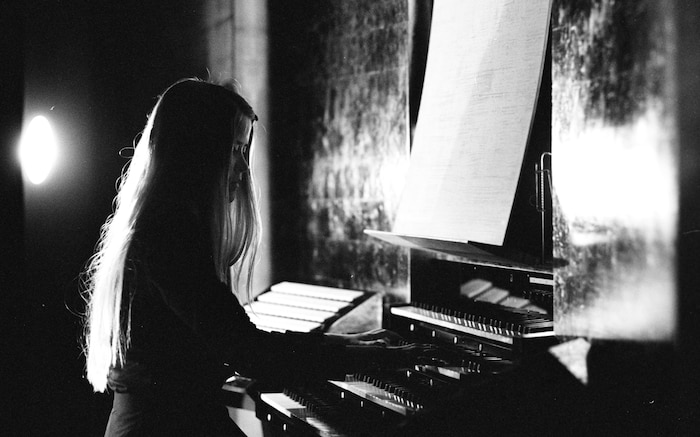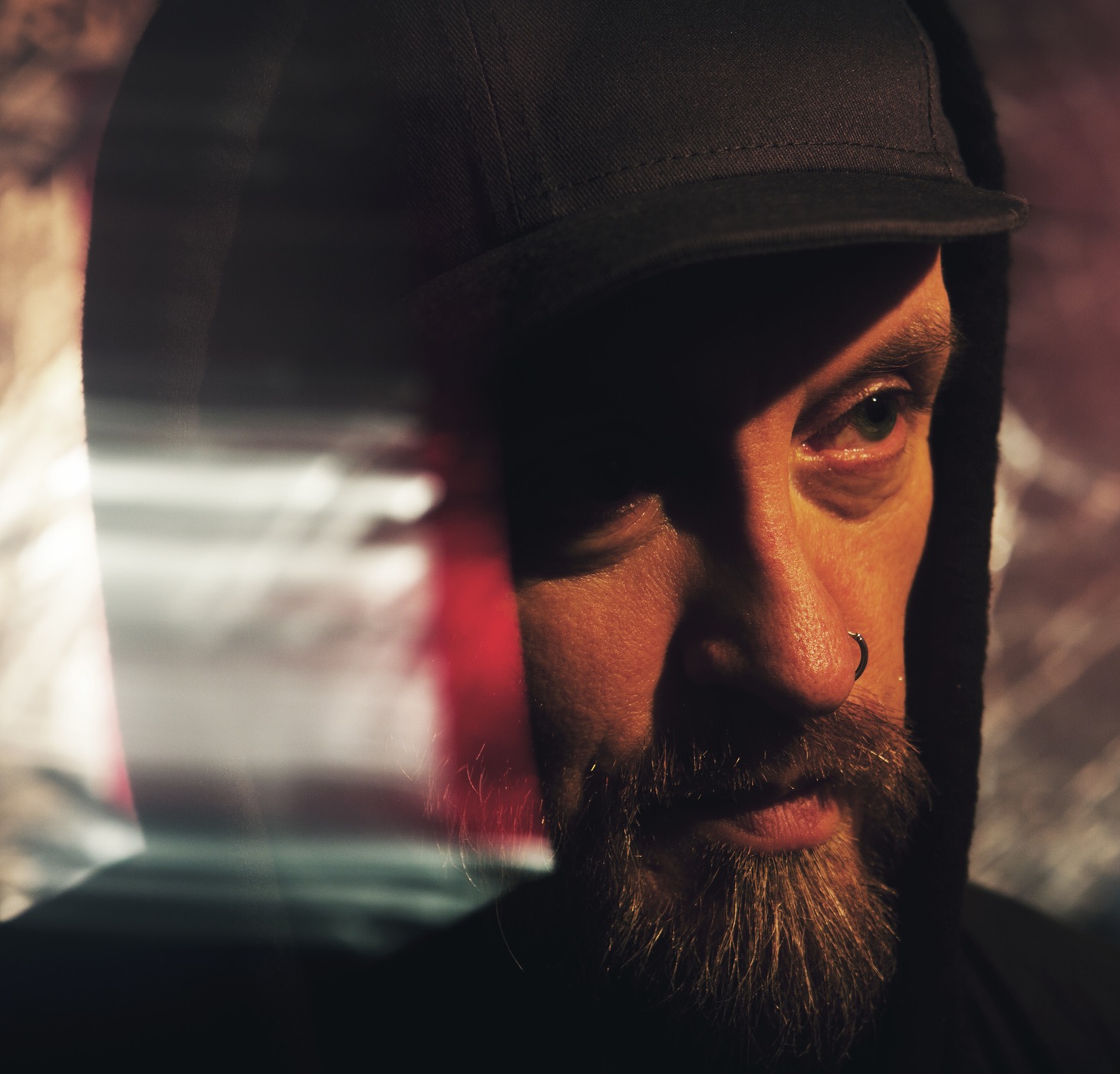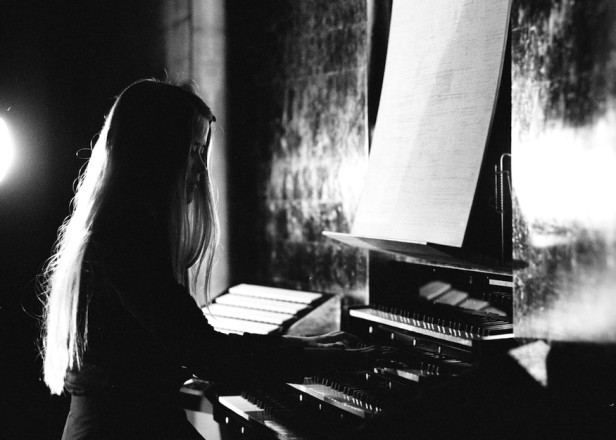Anna von Hausswolff’s Favorite Songs
The Swedish musician highlights her musical inspirations, from Satie to Sunn O)))

Hailing from Gothenburg, Sweden, Anna von Hausswolff is a singer, pianist, organist and songwriter, not to mention the daughter of famed sound artist Carl Michael von Hausswolff. Making her performance debut in 2008, she quickly joined Sweden’s local festival circuit, and the release of her 2010 debut LP, Singing From The Grave, solidified her status as a young talent to watch. Although early efforts drew favorable comparisons to the leftfield pop of artists like Kate Bush and Antony Hegarty, von Hausswolff switched up her sound significantly for 2012’s Ceremony, an expansive, organ-based album that proved to be her breakthrough release.
Since Ceremony, she’s continued to spread her wings, keeping her acrobatic voice front and center while incorporating elements of gothic folk, death metal, inventive pop and more into her cinematic musical vision. Von Hausswolff’s most recent full-length, 2015’s The Miraculous, found her making generous use of the Acusticum Pipe Organ in Piteå, Northern Sweden, whose colossal sound – the instrument has some 9000 pipes – swelled heroically throughout the record. In this condensed excerpt from her recent interview with Arno Raffeiner on RBMA Radio, von Hausswolff discussed some of her favorite songs, ranging from classic piano compositions to haunting opera.
Erik Satie – Gnossienne No. 1
I think this was one of the first songs that I played when I started to learn classical music, when I went from just the normal child, practicing things that you do on the piano, to playing more song-structured classical music. There are a few pianists who have been very important to me – Frédéric Chopin, Claude Debussy and Erik Satie – and I think all of these three composers taught me how to play melancholy.
Gnossienne No. 1 is the essence of melancholy. It’s super sad and very beautiful. It made a huge impact on me when I learned to play it. I was maybe 14 or 15 years old. I think what I liked about this song is that it wasn’t about learning the technique, but was more about finding the expression and sensitivity in the way that you played it. To be able to play it well, you had to be emotionally connected to it. It was very different than from playing Bach, who I never connected emotionally with. [Bach] was totally about the techniques, but Erik Satie, there was something in his harmonies and in his melodies that I could connect to emotionally. I would lose track of time playing this, and just float around in the soundscape. I probably played this song a hundred times. I still haven’t gotten tired of it. It’s also one of the first songs that I learned that I felt really connected to within classical music.
Of course, after when I was 16 and 17 years old, I learned lots of other classical pieces by other composers, but this is one of the few that I can actually remember. When I listen to it, I can still get really sad.
Jan Welmers - “Litanie”
I have no idea how I fell upon this Dutch composer. I probably Googled “contemporary pipe organ music,” and this was in 2010 when my interest for pipe organs started to grow. No one that I know seems to know about this guy, and I never have spoken with anyone whose heard of him.
When I Google him, it doesn’t seem like he has created a lot of official pieces. Maybe he has a wardrobe full of scores that he has never shown to anyone. This piece, “Litanie,” I remember when I heard it for the first time it filled me with enthusiasm and inspiration. He seems to be classically trained but he works a lot with repetition and has a very minimalistic way of playing the organ, which I can relate to. I could also relate during that time when I played the piano, because I’ve always composed my songs through repetition and, I guess, patterns. Adding patterns to patterns, but using simplicity as the main core of creating a song.
He did that, and I think what I truly connected to in this piece, and actually everything that I’ve heard that he’s done, is his way of combining simple harmonies and how he sneaks in beautiful melodies into these repetitious patterns. It’s very sad, but also enlightening in a way, and the music is extremely dynamic and things take time, a long time, before they develop into a dramatic landscape. You have to have patience listening to this kind of music. I think his music led me into a lot of other interesting pipe organ compositions, and I still haven’t found a match to Jan Welmers. He is still one of the best organ composers that I fell upon, even though I’ve only heard three pieces that he’s made.
György Ligeti - “Volumina”
I am still actually discovering Ligeti’s work. I heard this piece, “Volumina,” about two years ago, and it’s a piece that I still think about a lot. There is something in this piece that I think feels unexplored, and it’s something that I need to linger on. For me, this is like a piece more about the future rather than the past. It’s an organ landscape that I can relate to.
When I was in Piteå to do a concert, I talked to a guy called Claudius May-Woehl, who is the son of the pipe organ architect Gerald Woehl. Claudius is working together with his father, building new exploratory pipe organs. He told me about an interesting organ that they are making that has controlled pitches, so you can control the airflow to each pipe, which means that you can control the pitch of the note, the tone in the organ. I feel like this is the sort of pipe organ that Ligeti would appreciate. There are very few people who have explored pipe organ like Ligeti. He is using the full of register of the organ, and he explores and takes advantage of all the overtones that an organ can produce. When you can change the pitch in an organ, you also make the overtones change and slide into new territories.
I’ve never encountered anyone that is as good as Ligeti at using overtones and frequencies, because the overtones and frequencies are interfering and landing into each other. It’s very hard to hear what note is actually being played. This is a very typical hymn and I think that he would love that Claudius and Gerald Woehl “future pipe organ,” where he could control and manipulate the pitches in the notes.
Diamanda Galás - “Gloomy Sunday”
Diamanda Galás was my first encounter with experimental vocals. Before her, I was familiar with Patti Smith, Jeff Buckley, Morrissey, Thom Yorke – basically, people who use their voices in more traditional manners. Diamanda Galás was something new to me, something truly unique, and not mainstream in any way at all. She felt so free and unrestrained in her way of singing, and the combination of her wild vocals and her bluesy, classic way of playing the piano was and still is very inspiring. I loved how she hammered on the piano tangents and how she screamed. The screaming and the hammering, the primal things, really appeal to me.
I didn’t really understand all the words she sang, but it was more about the condition rather than the concept of the song to me. Or, it created a concept, the primal expression created something – I don’t know, anger or sadness, hysteria – lots of different emotions. She became my portal into a more expressive and aggressive, dark way of singing. There was a cover of “Gloomy Sunday” on my first EP, Track of Time, that I released in 2009. It was a tribute to her, really. Just listen to her version, because it’s much better than mine.
Klaus Nomi - “The Cold Song”
This was my first meeting with Klaus Nomi. I saw this live clip of him performing “The Cold Song” on YouTube, and it was just breathtakingly beautiful. It was actually the last performance he did before he died of AIDS. He is performing an aria of the Cold Genius from Henry Purcell’s King Arthur opera, and this concert was in ’82 and he died ’83, so it was really close to his death. My friend told me a little bit about the lyrics and the content of the lyrics before he played me this live clip, which I think made the impact even stronger. He told me about Nomi’s condition – that he had AIDS – and then he told me that the text that he is singing in this song is sung from a person who has just been awoken from death.
He’s been ordered to cover the landscape with ice and frost, but the person who has been awoken, he just wants to go back to sleep, and he begs for it. It’s a very sad song, and thinking about the strength that Klaus Nomi must have had before he entered the stage, and the bravery performing this kind of song in this text, is very special. It had a huge impact on me and it inspired me to write “Sova,” which is a track that is on my previous record Ceremony.
Earth had been introduced to me by my friend Christopher Cantillo, and he probably felt my need for a more artistic experimental music that isn’t too introverted or too complex to understand. He promised me that I would connect with Earth, and I totally did. They made a huge impact on me with their slow tempo, raw sound and reverb. It was like listening to a fusion between Black Sabbath and Ennio Morricone but playing in the wrong speed, pitched-down with super-long intervals between each note. I got addicted to Earth and I felt an urge to discover more bands of the same caliber. Wherever I went on the Internet searching for Earth or drone metal bands, Sunn O))) was always the one name that kept popping up. I started my Sunn O))) worshiping with Monoliths & Dimensions, which I think is a fantastic record. From there, I worked my way through their catalog. Black One is also my favorite, but the one album that really stood out to me, maybe because the use of pipe organ, was Dømkirke.
I also think that Attila [Csihar] is delivering amazing vocals, especially on this track. It’s not as throat singing-ish as his recent work or most of his work with Sunn O))). It’s not Mayhem-ish, either, but the way he’s singing this track, it sounds more desperate and more dramatic, and a bit more theatric, and almost a bit over-theatric, but in a good way. It’s so over the top, but in a good way. This feels very different to what I’ve heard from him before. That is also with Sunn O))) – the organ is divine and it suits their music perfectly.
Bohren & Der Club of Gore - “Staub”
I love the melodies in this song and I actually love this whole record, Dolores. I feel like it’s not trying to be anything. It just is what it is.
I don’t know how to explain it better, but this is the kind of music that I get truly lost in. It’s very sad, but it has some jazzy elements that really speak to me. The sound in general is very organic. It doesn’t feel static at all, even though it’s very repetitious. It’s also tight and heavy. I like that they can combine all these things and make it work.
If you like this track and if you get interested in this band, I recommend you to listen to the full album, because there are some other amazing tracks there as well. Some of them sound like they could be in a David Lynch movie and sometimes it just sounds like fucked-up elevator music, which I like. They have been important to me both in my solo project, but also in another project that I have together with Matti Bye, called Hydras Dream. Bohren & Der Club of Gore was our reference point for Hydras Dream. We interpret children’s tales into music and we write music for silent pictures, and Bohren & Der Club of Gore felt like a good starting point, as it’s very cinematic.
Mayhem - “Freezing Moon”
This was one of my first encounters with black metal. If you listen to black metal, you’ve probably heard this song, as its one of their hits.
This was also introduced to me in 2010, the year I moved to Copenhagen. I moved there and I started to discover a lot of new music. I was struck by the brutality of black metal. I was struck by Mayhem, and the vocals by Per Ohlin AKA Dead. In contrast to other metal music that I had listened to before, this felt more raw and unpolished, and not overproduced. I think at that time I had an urge to find aggressive music that felt primal and real, and this song, and Mayhem, and this whole album, felt very real. I think it was Mayhem and Burzum that were the first two black metal bands that I fell upon. These two bands have also remained my two favorite black metal bands.
Listen to Anna von Hausswolff’s Headphone Highlights and much more on the Beta version of the all-new RBMA Radio. Sign up for an invite code here and log in to listen.

